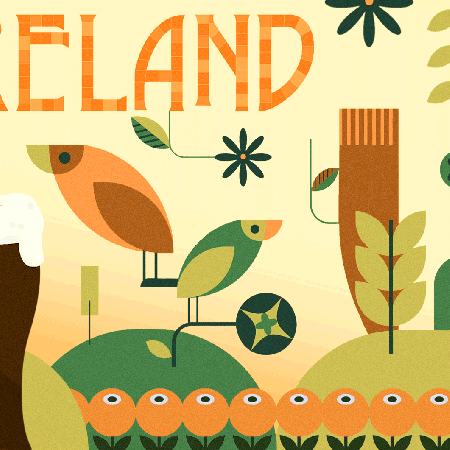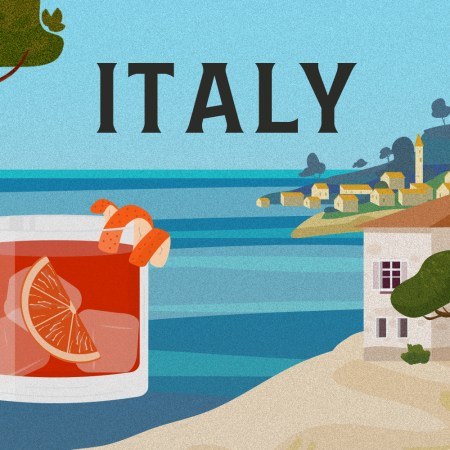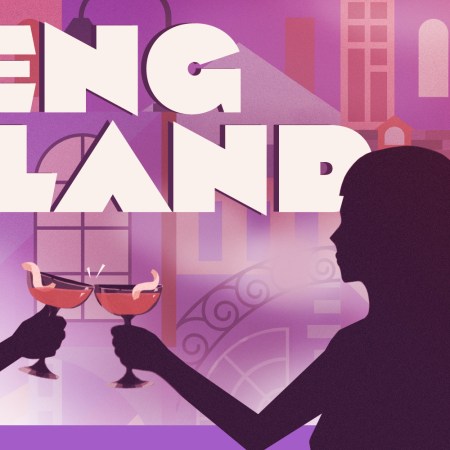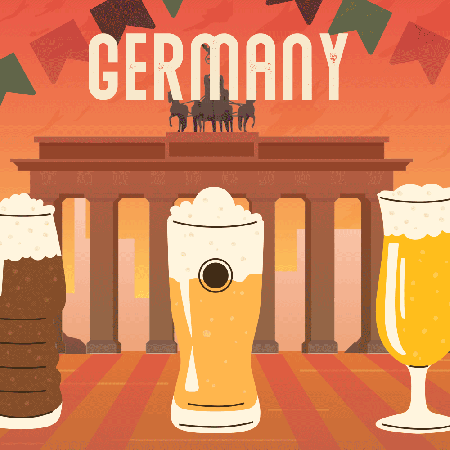
To celebrate the incredible drinking cultures of Europe, we dove deep into 10 different countries to get to know a little more about what’s in their glasses and how it got there in the first place. Click here to see them all.
This past spring, I spent four days in Lisbon just going to cocktail bars. It was a great way to avoid other tourists (who really are taking over) and experience what is low-key one of the most interesting drinking cities in the world. Before this year, my experience in Lisbon and Porto consisted primarily of basic rum and gin drinks (both easy enough to find in outdoor cafes), some local beer and, of course, Port wine. And you’ll certainly drink a lot of wine while you’re visiting the country, but Portugal feels like it’s on the verge of a boozy renaissance.
“Portugal is a small country but with a lot of cultural, gastronomic and beverage diversity,” says Nelson de Matos, bar manager at The Argo, a cocktail bar at Tivoli Marina Vilamoura in the Algarve region of Portugal (de Matos recently won the Best Bartender award at the 2024 Lisbon Bar Show). “From Douro region in the north to Bairrada, Alentejo or the Algarve, there’s a lot to discover.”
“The drinking culture is different depending on what part of the country you are in,” adds Mike Santos, Last Word Hospitality’s director of operations (including the Portuguese restaurant Barra Santos), whose family emigrated from Portugal to the United States during his childhood. “In the north, a lot of vinho verde and Port is consumed because that’s where it comes from. In the more central region, including Lisbon, there is more of a cosmopolitan vibe, so socially, cocktails, beer and wine are consumed. In the south, it is very touristy, so along with local wine, there is more of an international influence around drinking. Then there is Madeira, which produces Madeira wine and is commonly consumed both as an aperitif and a digestif.” (Speaking of vino, Portugal is still the leading European country in wine consumption per capita.)

Most importantly, drinking in Portugal remains a rather friendly affair, less geared toward excessive consumption and more about conviviality. “Consuming alcohol in Portugal is both more ubiquitous and more seamlessly integrated into daily life than it is in other places,” says Audrey Latura, a Porto-based expat behind the travel/gastronomy site An American in Portugal. “All cafes serve alcohol, and many places you might not expect to serve alcohol also do, like highway rest stops and hardware store snack bars. But binge drinking and public drunkenness are rare.” (Latura does add that, unfortunately, “young people have imported some of those behaviors from abroad.”)
“One of the biggest misperceptions about drinking in Portugal is that the culture revolves around heavy drinking or excessive consumption of alcohol,” Santos says. “In reality, drinking in Portugal is more about quality over quantity, particularly when it comes to wine. The Portuguese typically drink alcohol as part of a social or culinary experience, with a strong focus on pairing wine with meals.”

Port
Probably the beverage most commonly associated with Portugal, vinho do porto is a fortified wine produced in the Douro Valley of northern Portugal. Latura notes that it’s typically served at dessert because of its sweetness. “And that’s a shame because a good Port makes for an excellent aperitif paired with a strong, savory food, like cheese,” she says. Another good way to enjoy Port is in a Porto Tonico, or white Port and tonic water.
Madeira
Also a fortified wine, Madeira hails from an archipelago about 500 miles southwest of Portugal’s mainland. It can range in style from dry to sweet. The wine here undergoes the estufagem process, where it’s gently heated to accelerate its maturation, which imparts unique fruit, smoke and rancio characteristics (aka things like overripe fruit and melted or rancid butter).
Super Bock
If you drink domestic beer in Portugal, it’s most likely going to be this light and crisp pale lager or Sagres, a light-bodied Pilsner. “In small towns, beer can cost as little as one euro, making it the drink of choice for locals,” says Cyra Alcock, the regional director of Spain & Portugal for Walks and Devour Tours.

Vinho Verde
A young and fizzy wine (usually white) from the northwest of Portugal that’s high in acidity but low in alcohol.
Plus, the Homemade Thing:
Ginjinha is a cherry liqueur made by infusing sour ginja cherries in alcohol, typically aguardente, and adding sugar and other flavors like cinnamon. “It’s most commonly produced in Lisbon and is very popular amongst tourists and locals alike,” Santos says. “There are ginjinha houses throughout Lisbon where you can stop in for a quick shot.”
“I would highlight Algarve’s flagship distillate Medronho,” de Matos says. “It’s a fruit brandy very typical of this region.” It’s a bit of a local firewater/grappa that works best in a coffee.
“Bagaço is the Portuguese version of grappa,” Alcock says. “In a way, it’s an ode to Portugal’s 14 different wine regions. It’s normal for families to do homemade bagaço.”

The Douro & Porto Wine Festival is probably the largest event in Portugal. “It’s also the newest and most commercial,” Latura says. “If you really want to experience something authentically Portuguese, check out one of the Midsummer festivals that take place throughout the country in the month of June, [called] santos populares in Portuguese. Traditional food, drinks and music come alive in city-wide parties. Men sweat before huge fires grilling fresh sardines. Women make salads and drop off the sardines at picnic-style tables set out for the occasion.”
Festa de São João (Festival of Saint John) is one of Portugal’s biggest and most vibrant festivals, according to Santos. The most popular is held in Porto, and it celebrates the summer solstice and Saint John the Baptist.

Festa das Vindimas (Wine Harvest Festival) is another big festival. The largest is held in the Douro Valley, but other wine regions also celebrate the grape harvest season with music, food and, obviously, wine.
Carnival occurs in Portugal every year on Shrove Tuesday and is celebrated throughout the country. “It takes place at the end of winter and happens on the streets, where visitors can enjoy music, food, parades, traditional Portuguese food and plenty of local booze,” says Madison Krigbaum, a travel blogger who recently lived in Portugal.


“The Portuguese mostly drink alcohol with a regular meal, but if the objective of the evening is to get lit, then what you need are petiscos, small plate dishes similar in style to Spanish tapas but not the same,” Latura says. “Some classics of the genre include bolinhos de bacalhau (codfish cakes with potato, called pastéis de bacalhau in Lisbon and southern Portugal), pica-pau (sautéed pork and sausages) and caracois (snails).”
Tremoços are pickled lupini beans that are lightly salted and served as a snack in most bars throughout Portugal. They are often enjoyed with a cold beer, and because they are salty, “it’s easy to have a few beers with them,” Santos says.
Hot tip if you’re in Lisbon: according to Krigubaum, if you’re drinking near Pink Street, A Merendeira is a drunk food institution. They’re open until 7:00 a.m. and sell thousands of pão com chorizo per week (cheese and chorizo baked into bread). Finally, if you’re in Porto, try a francesinha and pair it with beer. It’s a hearty sandwich with many, many layers of meats and cheese covered in more cheese, egg and hot sauce.

Pavilhão Chinês
A bar in the very cool Bairro Alto neighborhood of Lisbon that’s more like a multi-room museum, chock full of vintage toys and model planes.


A charming Porto wine bar located in a former church.
A small bar near Rossio Square in Lisbon that serves only ginjinha, the famous cherry liqueur.
“There are all these cool new wine bars in Porto,” Alcock says. “It’s breathing new life into the Portuguese wine world. This one is a favorite — it’s right on the river with lots of local wines by the glass and cheese boards.”
“It’s a legendary seafood restaurant and beer house in Lisbon,” Santos says. “It’s the best seafood spot in the city, and it has a vibrant drinking culture with locals often enjoying beer or vinho verde.”
While downtown Lisbon can feel really touristy nowadays, this tiny, modern bar serves as a quiet and cool respite. Almost everything here, including the booze, is local and/or made from scratch.


1. When among friends, buy a round of drinks: And go local when you’re doing so. “There are small typical restaurants that we call ‘tascas,’” de Matos says. “ These are places where people gather to snack and drink.”
2. Don’t get publicly drunk: “That’s what foreigners do,” Latura says.
3. Sip and savor your drink: “In Portugal, drinking is typically a social and culinary experience and not about drinking in excess or rushing,” Santos says. “Locals generally are sipping their beverage, enjoying it with food and good company.”
4. Experiment with wine, but drink beer when socializing: According to Alcock, it’s wine with meals and beer with friends. And she notes, never drink Port with a meal — it’s for savoring after.

Porto Tonico
“We feature one of the more common drinks in Portugal: Porto Tonico,” says Evelyn Goreshnik, the wine director at Barra Santos. “It’s white Port — which has a very slight sweetness but is fairly dry — served over pebble ice and finished with tonic. A lemon peel finishes this simple but extremely delicious drink, and you’re ready to sip at least three of these without flinching.”
2 oz. Niepoort Dry White Port
Boylan Heritage Tonic
Lemon zest, for garnish
Add Port to an 8-ounce glass. Fill with ice (preferably pebble ice). Top with tonic and garnish with lemon zest.

Made in Douro
1 oz. gin
1 oz. white Port wine (or substitute Jerez sherry or Sauternes)
1 oz. orange and pepper cordial
.75 oz rosemary syrup (simple syrup seasoned with rosemary)
1 oz. lemon juice
1 egg white
Dash of orange bitters (optional)
Rosemary sprig, for garnish
Crushed black pepper, for garnish
Combine liquid ingredients in a cocktail shaker with ice. Shake and strain into a coupe glass topped with a rosemary sprig and crushed black pepper.
Join America's Fastest Growing Spirits Newsletter THE SPILL. Unlock all the reviews, recipes and revelry — and get 15% off award-winning La Tierra de Acre Mezcal.



